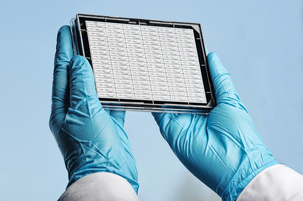
Together with Participatiemaatschappij Oost Nederland NV (PPM Oost), the Zeeuws Investment Fund invests in MIMETAS. MIMETAS is a company that develops and manufactures microfluidic chips equipped with cultured biological tissues. The investment is mainly used to further ensure development of the technology and to start production.
MIMETAS technology, so-called OrganoPlates™, is equipped with microfluidic chips with cultured biological tissues that mimic the structure and function of human organs. “Our organ models are more predictive than laboratory animals or standard two-dimensional cell cultures,” says Paul Vulto of MIMETAS. “This is because we grow human cells in a three dimensional environment, with a type of blood stream alongside. Furthermore, we can connect various tissues, allowing them to communicate with each other.”
"The need for so-called ‘Organ-on-a-Chip’ models is growing", says Vulto. “The development of new medicine is a huge financial cost. In addition, medicine become increasingly more complex. Our organs on a chip make it possible to, at an early stage, predict the effect of medicine on people or a certain sub group of patients. This results in the removal of a significant portion of the development risk.”
Together with Jos Joore, Vulto founded MIMETAS in Leiden in 2013. At the end of 2013, a cooperation agreement was signed with the listed pharmaceutical company Galapagos, which has great confidence in the future of MIMETAS. Richard Janssen, Senior Director of Target Discovery at Galapagos: “The MIMETAS platform is the first to combine organ-on-a-chip technology with our high throughput screening of primary human cells. As we see it, OrganoPlates make 3D culture as straightforward as traditional cell culture.”
Johan Sebregts, director of the Zeeuws Investment Fund, is impressed with the technology and management of MIMETAS: “MIMETAS brings nanotechnology and biotechnology together in an innovative product, which tackles major social issues, such as animal testing and the ever-rising costs of medicine. This unique technology in combination with a highly experienced and expert management team gives us great confidence in realizing the potential of MIMETAS.”
More information about MIMETAS.
MIMETAS technology, so-called OrganoPlates™, is equipped with microfluidic chips with cultured biological tissues that mimic the structure and function of human organs. “Our organ models are more predictive than laboratory animals or standard two-dimensional cell cultures,” says Paul Vulto of MIMETAS. “This is because we grow human cells in a three dimensional environment, with a type of blood stream alongside. Furthermore, we can connect various tissues, allowing them to communicate with each other.”
"The need for so-called ‘Organ-on-a-Chip’ models is growing", says Vulto. “The development of new medicine is a huge financial cost. In addition, medicine become increasingly more complex. Our organs on a chip make it possible to, at an early stage, predict the effect of medicine on people or a certain sub group of patients. This results in the removal of a significant portion of the development risk.”
Together with Jos Joore, Vulto founded MIMETAS in Leiden in 2013. At the end of 2013, a cooperation agreement was signed with the listed pharmaceutical company Galapagos, which has great confidence in the future of MIMETAS. Richard Janssen, Senior Director of Target Discovery at Galapagos: “The MIMETAS platform is the first to combine organ-on-a-chip technology with our high throughput screening of primary human cells. As we see it, OrganoPlates make 3D culture as straightforward as traditional cell culture.”
Johan Sebregts, director of the Zeeuws Investment Fund, is impressed with the technology and management of MIMETAS: “MIMETAS brings nanotechnology and biotechnology together in an innovative product, which tackles major social issues, such as animal testing and the ever-rising costs of medicine. This unique technology in combination with a highly experienced and expert management team gives us great confidence in realizing the potential of MIMETAS.”
More information about MIMETAS.
